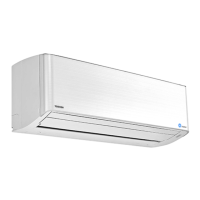Do you have a question about the Toshiba RAS-M13UKCV-E3 and is the answer not in the manual?
Detailed specifications for various models, including capacity, power, noise, dimensions, and piping.
Graphs showing operation characteristics based on inverter frequency, outdoor temperature, and pipe length.
Electrical data for outdoor units, including system, compressor, and fan motor specifications.
Crucial safety precautions for handling R410A refrigerant during installation and servicing.
Guidelines for installing refrigerant piping, including materials, joints, and processing procedures.
Lists required tools for R410A installation and general tools that can be used.
Step-by-step procedure for recharging refrigerant, emphasizing correct amount and method.
Details on brazing materials, flux, and the brazing method to prevent oxidation.
Detailed diagrams and dimensions of the indoor unit and its components.
Detailed diagrams and dimensions of the outdoor unit and its components.
Wiring diagram for the indoor unit, including terminal block and component connections.
Wiring diagram for the outdoor unit, showing connections to various components and boards.
List of electrical parts used in the indoor unit with their specifications.
List of electrical parts used in the outdoor unit with their specifications.
Operational data for cooling and heating modes, including temperatures, pressures, and speeds.
Block diagram showing the control functions and signal flow for the indoor unit.
Block diagram illustrating the control system and components of the outdoor unit inverter assembly.
Overview of the air conditioner's control system, including indoor and outdoor unit functions.
Detailed description of cooling operation modes, including capacity control and fan speed.
Explanation of temporary operation modes like Auto Restart and Temporary Cooling.
Instructions on how to set, cancel, and manage the auto restart function after power failure.
Description of the remote control functions, buttons, and display indications.
General safety warnings and cautions for installation, including electrical and refrigerant handling.
Procedures for installing the indoor unit, including accessory parts and mounting.
Guidelines for installing the outdoor unit, including piping, placement, and electrical work.
Initial checks for power supply, voltage, and normal operation conditions.
Methods for initial trouble diagnosis using indoor unit LEDs and remote control self-diagnosis.
Interpreting indoor unit LED indications for self-diagnosis of faults.
Using the remote control in service mode to retrieve check codes for fault diagnosis.
Troubleshooting steps based on specific symptoms like no power or fan motor issues.
Interpreting outdoor unit LED indicators for self-diagnosis of faults.
Flowchart for diagnosing inverter assembly troubles in the outdoor unit.
Procedures for checking main components like P.C. boards, motors, and sensors.
Guide to diagnosing the condition of the outdoor fan motor.
Step-by-step instructions for replacing main parts of the indoor unit.
Procedure for replacing the microcomputer assembly in the air conditioner.
Step-by-step instructions for detaching and replacing parts of the outdoor unit.
Exploded view and parts list for the indoor unit components.
Exploded view and parts list for the outdoor unit components.
Layout diagrams for P.C. boards used in the air conditioner system.
| Brand | Toshiba |
|---|---|
| Model | RAS-M13UKCV-E3 |
| Category | Air Conditioner |
| Language | English |











